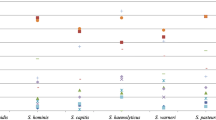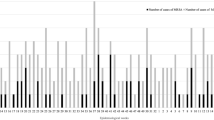Abstract
Staphylococcus argenteus is a novel Staphylococcus species closely related to Staphylococcus aureus that has been recently described. In this study, we investigated the proportion and the characteristics of S. argenteus recovered from humans in Belgium. S. aureus. human isolates collected in Belgium from 2006 to 2015 (n = 1,903) were retrospectively characterised via the presence of non-pigmented colonies on chocolate agar, spa typing and rpoB sequencing to determine if some of them were in fact S. argenteus. Out of 73 strains non-pigmented on chocolate plates, 3 isolates (0.16 %) showed rpoB sequences, in addition to spa and sequence types (ST2250/t5787, ST2250/t6675, ST3240/t6675), related to S. argenteus. Two of them were methicillin-resistant, harbouring a SCCmec type IV. The three S. argenteus isolates carried genes (sak, scn) of the immune evasion cluster. This first Belgian nationwide analysis showed a low occurrence of S. argenteus. Further studies should be conducted to identify the distribution range and the clinical impact of this new species.

Similar content being viewed by others
References
Tong SY, Schaumburg F, Ellington MJ et al (2015) Novel staphylococcal species that form part of a Staphylococcus aureus-related complex: the non-pigmented Staphylococcus argenteus sp. nov. and the non-human primate-associated Staphylococcus schweitzeri sp. nov. Int J Syst Evol Microbiol 65:15–22
McDonald M, Dougall A, Holt D et al (2006) Use of a single-nucleotide polymorphism genotyping system to demonstrate the unique epidemiology of methicillin-resistant Staphylococcus aureus in remote aboriginal communities. J Clin Microbiol 44:3720–3727
Ng JW, Holt DC, Lilliebridge RA et al (2009) Phylogenetically distinct Staphylococcus aureus lineage prevalent among indigenous communities in northern Australia. J Clin Microbiol 47:2295–2300
Ruimy R, Angebault C, Djossou F et al (2010) Are host genetics the predominant determinant of persistent nasal Staphylococcus aureus carriage in humans? J Infect Dis 202:924–934
Thaipadungpanit J, Amornchai P, Nickerson EK et al (2015) Clinical and molecular epidemiology of Staphylococcus argenteus infections in Thailand. J Clin Microbiol 53:1005–1008
Holt DC, Holden MT, Tong SY et al (2011) A very early-branching Staphylococcus aureus lineage lacking the carotenoid pigment staphyloxanthin. Genome Biol Evol 3:881–895
Tong SY, Sharma-Kuinkel BK, Thaden JT et al (2013) Virulence of endemic nonpigmented northern Australian Staphylococcus aureus clone (clonal complex 75, S. argenteus) is not augmented by staphyloxanthin. J Infect Dis 208:520–527
Tong SY, Lilliebridge RA, Bishop EJ et al (2010) Clinical correlates of Panton-Valentine leukocidin (PVL), PVL isoforms, and clonal complex in the Staphylococcus aureus population of Northern Australia. J Infect Dis 202:760–769
Dupieux C, Blonde R, Bouchiat C et al (2015) Community-acquired infections due to Staphylococcus argenteus lineage isolates harbouring the Panton-Valentine leucocidin, France, 2014. Euro Surveill 20:21154
Blumental S, Deplano A, Jourdain S et al (2013) Dynamic pattern and genotypic diversity of Staphylococcus aureus nasopharyngeal carriage in healthy pre-school children. J Antimicrob Chemother 68:1517–1523
Deplano A, Vandendriessche S, Nonhoff C et al (2014) Genetic diversity among methicillin-resistant Staphylococcus aureus isolates carrying the mecC gene in Belgium. J Antimicrob Chemother 69:1457–1460
Mellman A, Becker K, von Eiff C et al (2006) Sequencing and staphylococci identification. Emerg Infect Dis 12:333–336
Monecke S, Stieber B, Roberts R et al (2014) Population structure of Staphylococcus aureus from Trinidad & Tobago. PLoS One 9:e89120
Clinical and Laboratory Standards Institute (2014) Performance standards for antimicrobial susceptibility testing: twenty-fourth informational supplement M100-S24. CLSI, Waye, Pennsylvania, USA
Jenney A, Holt D, Ritika R et al (2014) The clinical and molecular epidemiology of Staphylococcus aureus infections in Fiji. BMC Infect Dis 14:160
Chantratita N, Wikraiphat C, Tandhavanant S et al (2016) Comparison of community-onset Staphylococcus argenteus and Staphylococcus aureus sepsis in Thailand: a prospective multicentre observational study. Clin Microbiol Infect. doi:10.1016/j.cmi.2016.01.008
Ruimy R, Armand-Lefevre L, Barbier F et al (2009) Comparisons between geographically diverse samples of carried Staphylococcus aureus. J Bacteriol 191:5577–5583
Fey PD, Endres JL, Yajjala VK et al (2013) A genetic resource for rapid and comprehensive phenotype screening of nonessential Staphylococcus aureus genes. MBio 4:e00537-12
Acknowledgements
We thank our microbiologist colleagues for sending their staphylococci strains to the NRC.
Author information
Authors and Affiliations
Corresponding author
Ethics declarations
Nucleotide accession numbers
The rpoB sequences generated in this study were deposited in GenBank: accession numbers KU555518 to KU555590).
Funding
This study was supported by internal funding.
Conflicts of interest
The authors declare that they have no conflicts of interest.
Ethical approval
For this type of study formal consent is not required.
Electronic supplementary material
Below is the link to the electronic supplementary material.
ESM 1
(PDF 41 kb)
Rights and permissions
About this article
Cite this article
Argudín, M.A., Dodémont, M., Vandendriessche, S. et al. Low occurrence of the new species Staphylococcus argenteus in a Staphylococcus aureus collection of human isolates from Belgium. Eur J Clin Microbiol Infect Dis 35, 1017–1022 (2016). https://doi.org/10.1007/s10096-016-2632-x
Received:
Accepted:
Published:
Issue Date:
DOI: https://doi.org/10.1007/s10096-016-2632-x




